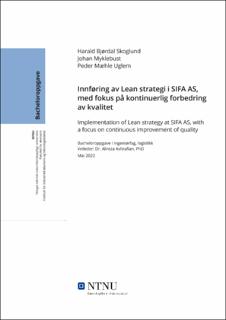| dc.contributor.advisor | Ashrafian, Dr. Alireza | |
| dc.contributor.author | Skoglund, Harald Bjørdal | |
| dc.contributor.author | Myklebust, Johan | |
| dc.contributor.author | Uglem, Peder Mæhle | |
| dc.date.accessioned | 2022-07-20T17:19:55Z | |
| dc.date.available | 2022-07-20T17:19:55Z | |
| dc.date.issued | 2022 | |
| dc.identifier | no.ntnu:inspera:112277671:112286708 | |
| dc.identifier.uri | https://hdl.handle.net/11250/3007362 | |
| dc.description.abstract | Oppgaven bygger videre fra prosjektoppgave, hvor det ble identifisert årsaker og kostnader for avvik og reklamasjoner i SIFA AS. Resultatene fra prosjektoppgave viste ordresett som stor årsak til avvik og kostnader. Dette ga bacheloroppgavens problemstilling “Hvordan senke avvik og reklamasjoner med årsak i ordresett hos SIFA AS?”. Det resulterte også i tre resultatmål som omfatter gjennomføring av Lean-arbeid i form av et PDCA-prosjekt, presentere alternativer for videre PDCA-prosjekter og senke antall avvik. Gjennom teorikapitlet belyses kontinuerlig forbedring og Lean-verktøy som PDCA-hjulet, paretoanalyser, 5 x hvorfor, rotårsaksanalyser og teori rundt standardisering. Videre informeres det om viktigheten til hverdagsledelse og visuell ledelse.
Prosjektet bestod i stor grad av gjennomføring av PDCA-prosjekt, med kvantitative og kvalitative metoder for innhenting av nødvendig data, resultater og sammenligningsgrunnlag. Dette i form av modifiserte kategorier og analyser i avviksregisteret til bedriften, spørreundersøkelse og semistrukturerte intervjuer med involverte parter. Resultatet av dette ga en beskrivelse av stegene i et PDCA-prosjekt, fra planleggings- til korrigeringsfase. Underveis resulterte forbedringsarbeidet i tre tiltakspakker tilknyttet ordresettutforming, standardisert nivåinndeling i produktbeskrivelser og en sluttkontroll for avviksavdekking. Gjennomføringsfasen for tiltakene varte i ca. fem uker.
Feilkilder som kort tidsrom, forskyving mellom ordresettutforming og faktisk produksjon, avviksregistrering og studentenes ledelsesevner påvirket oppgaven. Det ble konkludert med delvis oppnåelse av resultatmål 1 og 2, samtidig som resultatmål 3 ikke hadde tilstrekkelig med sammenligningsdata til å vurderes. Konklusjonen om oppnådde mål ble i hovedsak tatt på bakgrunn av ansattes tilbakemeldinger fra gjennomføringfasen. Effektmålene er ikke vurdert som oppnådd, men det konkluderes at videreførelse av tiltakene gir potensial for oppnåelse.
Etter forbedringsarbeidet tilknyttet ordresett, standardiserte nivå og sluttkontroll, ble det anbefalt tre videre arbeidsområder hvor SIFA bør bruke PDCA-hjulet. Gjeldende områder var revisjonslagring, standardisering av informasjon ut til produksjon og en fullverdig sluttkontroll. | |
| dc.description.abstract | The assignment continues where the project assignment ended, where the causes and costs of defects internally and externally in SIFA AS were identified. The results fra the project assignment showed order layouts as a major reason for deviations. This generated the problem “How to lower defects and notification of complaints with cause in order layouts at SIFA AS?”. It also generated three performance targets that include implementation of Lean work in the form of a PDCA project, present alternatives for future PDCA projects and reduce the number of discrepancies. Throughout the theory chapter, continuous improvement and Lean tools such as PDCA, pareto analysis, 5x why, root-cause analysis and theory regarding standardization are explained. Furthermore, it informs about the importance of daily management and visual management.
The project largely consisted of the implementation of a PDCA-project, with quantitative and qualitative methods for obtaining the necessary data, results and a basis for comparison. The results were shown in the form of modified categories and analyzes in the defects register of the company, a survey and several semi-structured interviews with the involved parties. The result gave a description of the steps in a PDCA-project, fra the “planning” phase to the “acting” phase. Along the way, the work resulted in three different packages of measures associated with order layouts, standardized level-division for product-descriptions and a final quality check. The “do” phase lasted for approx. five weeks, fra which the data originates.
Sources of error such as a short period of time, shifts between order layout implementation and actual production, deviation registration related issues and the students' management skills affected the task. It was concluded that partial achievement of performance targets 1 and 2 was achieved. At the same time, performance target 3 did not have sufficient data to be evaluated. The conclusion regarding achieved goals was mainly based on employees' feedback from the “do” phase. The effect-goals are not evaluated to have been achieved, but it is concluded that the continuation of the measures has the potential for achieving them.
Following the work associated with the order layout, standardized levels and quality check, three further work areas were recommended to SIFA, where they should use the PDCA-method. These areas were file storage, standardization of informational flow into the production area and a fully developed quality control. | |
| dc.language | nob | |
| dc.publisher | NTNU | |
| dc.title | Innføring av Lean strategi i SIFA AS, med fokus på kontinuerlig forbedring av kvalitet | |
| dc.type | Bachelor thesis | |
